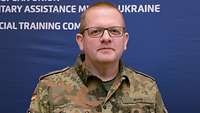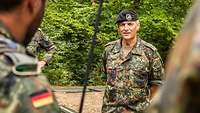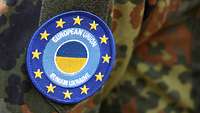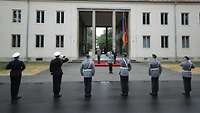Fast and flexible: the EUMAM UAEuropean Union Military Assistance Mission Ukraine Special Training Command
Fast and flexible: the EUMAM UAEuropean Union Military Assistance Mission Ukraine Special Training Command
- Date:
- Place:
- Strausberg
- Reading time:
- 6 MIN
At the Special Training Command in Strausberg, more than 100 soldiers from around 15 nations coordinate all training courses conducted on German soil within the framework of the EUMAM UAEuropean Union Military Assistance Mission Ukraine training mission. Colonel (GSGeneral Staff) Haub, the Chief of Staff, gives an insight into his work.
Colonel, in your function as Chief of Staff you coordinate the work at the ST-C. What is the normal planning process for the various training courses?
The planning of Ukraine's required training activities formally starts with Ukraine submitting a training request to the EUEuropean Union Military Planning and Conduct Capability in Brussels. Apart from such formal requests, we are in close contact with our staff’s Ukrainian liaison officer to adapt the training to changed requirements. In addition, the ST-C makes suggestions on how to continuously improve and adapt the training based on observations of the war in Ukraine and lessons learned from previous trainings. The ST-C in Strausberg evaluates the training requirements in terms of implementation, tasks Bundeswehr training units or requests partner nations to conduct the training, coordinates the necessary resources, and submits the training for approval in order to request funding from the EUEuropean Union.
All in all, we have succeeded in establishing a training system that can respond quickly and flexibly to Ukraine's needs. The different elements of the ST-C are then tasked with creating the organisational prerequisites and specifying the framework and the training objective by means of training directives. The responsibility to decide about the exact design of the training, however, lies with the respective chief instructors on site. Through direct cooperation with the Ukrainian soldiers, they are in a better position to estimate how the training objective can be achieved under the given conditions.
The ST-C is composed of soldiers from numerous nations. Tell us about the benefits but also about the challenges that arise as a result.
One third of the posts at the ST-C are manned by soldiers of our multinational allies, which in itself is a great benefit but also requires a high degree of adaptability from all participants. Even within NATONorth Atlantic Treaty Organization, not all processes and procedures are the same. It is therefore always necessary to coordinate with each in order to act jointly and align our efforts.
The participation of all nations in the staff greatly helps to implement the required coordination in the planning of the training in a timely manner. It is beyond question that a mission of this scale can only be accomplished together with our allies. The Bundeswehr as the backbone of the mission provides infrastructure, logistic support and medical care as well as most instructors, but our 15 partner nations also make decisive contributions – some by assuming the responsibility for conducting entire training modules on German soil.
Even nations with comparatively small armed forces have the opportunity to actively participate in the training of Ukrainian soldiers due to the organisational framework that Germany provides in its capacity as lead nation of the ST-C. By means of a joint commitment in planning and execution, we are meanwhile able to train an average of 600 soldiers per day in a wide variety of training modules.
Which aspects of planning or training still require improvement?
With the short-term European decision to establish the ST-C in November 2022, the Bundeswehr has demonstrated its "cold-start capability" and flexibility: Within a very short time, a multinational staff was established and the number of training measures conducted in Germany was increased under the mandate of the EUEuropean Union.
The achievements of the past year were impressive. There is certainly further room for improvement, be it in the field of multinational coordination with our various partners that provide training for Ukrainian soldiers in their respective countries or in terms of Ukrainian feedback regarding the effectiveness of the individual training measures.
An even stronger feedback would be helpful, which is why we invite an increasing number of Ukrainian experts to Germany for a mutual exchange of information. We must not forget, however, that Ukraine is at war and therefore simply cannot afford the desirable luxury of reliable long-term planning.
You have been assigned to the ST-C for almost six months now. What has this mission given to you as a person?
Personally, this mission has given me the opportunity to work together with soldiers from numerous nations and thus to get to know new perspectives. What is much more important, however, is that I can be part of a mission that actually makes a difference. Over the past twelve months, we have been able to train about 8,000 Ukrainian soldiers in more than 200 training modules, and the motivation and fighting spirit of the soldiers is really impressive.
The Ukrainian soldiers are needed at the front, which limits the time available for the training in Germany and requires a focus on what is essential. This war will take its toll, but with each training we can significantly increase the chances of survival on the battlefield thanks to the great commitment of all participants, both instructors and support personnel.
Contributing to Ukraine's fight against the Russian aggressor and making things possible quickly and straightforwardly is very rewarding in terms of job satisfaction. At the ST-C, the new era of security policy has fully begun.
What will the future of EUMAM UAEuropean Union Military Assistance Mission Ukraine under the Special Training Command be like?
In 2024, we will continue to tailor and adapt the training to the needs of Ukraine. Although we are generally well-informed about the course of the war, only the Ukrainian military can assess the actual effects and decide which training courses are required. In order to achieve effective and sustainable success with this mission, we will focus even more on the training of Ukrainian command personnel in the future.
The Ukrainian feedback that our conveyed Western leadership philosophies are accepted and applied tells us that the training is starting to bear fruit. Our aim is to further develop the mission in such a way that Ukraine can train its troops more independently in the long run, while the ST-C continues to provide the organisational framework. Moreover, we have to pay even more attention to the new challenges identified in this war, for example by increasingly integrating the use of drones into various training measures.
In the end, however, the further course of this mission will be determined solely by the unpredictable course of the war, and we must be ready to respond to it quickly and flexibly at any time. Even though the exact future of the mission is uncertain, one thing is clear: We will support Ukraine as long as necessary and as best we can. Ukraine is at war, the deterrence of which is the reason we are serving in the armed forces.






